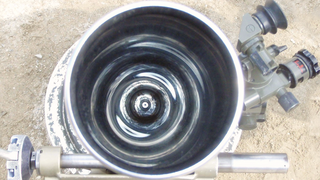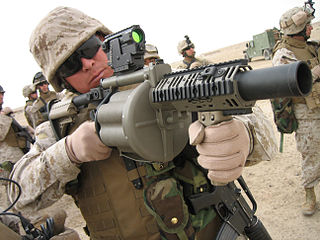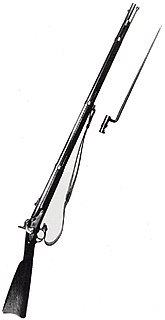
Shrapnel shells were anti-personnel artillery munitions which carried a large number of individual bullets close to the target and then ejected them to allow them to continue along the shell's trajectory and strike the target individually. They relied almost entirely on the shell's velocity for their lethality. The munition has been obsolete since the end of World War I for anti-personnel use, when it was superseded by high-explosive shells for that role. The functioning and principles behind Shrapnel shells are fundamentally different from high-explosive shell fragmentation. Shrapnel is named after Major-General Henry Shrapnel (1761–1842), a British artillery officer, whose experiments, initially conducted on his own time and at his own expense, culminated in the design and development of a new type of artillery shell.

A grenade launcher is a weapon that fires a specially-designed large-caliber projectile, often with an explosive, smoke or gas warhead. Today, the term generally refers to a class of dedicated firearms firing unitary grenade cartridges. The most common type are man-portable, shoulder-fired weapons issued to individuals, although larger crew-served launchers are issued at higher levels of organisation by military forces.

An electroshock weapon is an incapacitating weapon. It delivers an electric shock aimed at temporarily disrupting muscle functions and/or inflicting pain without causing significant injury.

A smoothbore weapon is one that has a barrel without rifling. Smoothbores range from handheld firearms to powerful tank guns and large artillery mortars. The majority of shotguns are smoothbores and the term can be synonymous.

The Minié ball, or Minni ball, is a type of muzzle-loading spin-stabilized bullet for rifled muskets named after its co-developer, Claude-Étienne Minié, inventor of the French Minié rifle. It came to prominence in the Crimean and American Civil War.
The .30-06 Springfield cartridge, 7.62×63mm in metric notation and called ".30 Gov't '06" by Winchester, was introduced to the United States Army in 1906 and later standardized; it remained in use until the early 1980s. The ".30" refers to the caliber of the bullet in inches. The "06" refers to the year the cartridge was adopted—1906. It replaced the .30-03, 6mm Lee Navy, and .30-40 Krag cartridges. The .30-06 remained the U.S. Army's primary rifle and machine gun cartridge for nearly 50 years before being replaced by the 7.62×51mm NATO and 5.56×45mm NATO, both of which remain in current U.S. and NATO service. It remains a very popular sporting round, with ammunition produced by all major manufacturers.

In current usage a riot gun or less-lethal launcher is a type of firearm that is used to fire "non-lethal" or "less-lethal" ammunition for the purpose of suppressing riots. Less-lethal launchers may be special purpose firearms designed for riot control use, or standard firearms, usually shotguns and grenade launchers, adapted to riot control use with appropriate ammunition. The ammunition is most commonly found in 12 gauge shotguns and 37mm/40 mm grenade launchers.

A rifled musket is a type of firearm made in the mid-19th century. The term referred only to muskets that had been produced as a smoothbore weapon and later had their barrels rifled. The term 'rifle musket' refers to musket length firearms that were manufactured with rifled barrels. The two terms are frequently confused.
A pulsed energy weapon is any weapon that:

The columbiad was a large-caliber, smoothbore, muzzle-loading cannon able to fire heavy projectiles at both high and low trajectories. This feature enabled the columbiad to fire solid shot or shell to long ranges, making it an excellent seacoast defense weapon for its day. Invented by Colonel George Bomford, United States Army, in 1811, columbiads were used in United States seacoast defense from the War of 1812 until the early years of the 20th century. Very few columbiads were used outside of the U.S. and Confederate Armies; nevertheless, the columbiad is considered by some as the inspiration for the later shell-only cannons developed by Frenchman Henri-Joseph Paixhans some 30 years later.

Hunting weapons are weapons designed or used primarily for hunting game animals for food or sport, as distinct from defensive weapons or weapons used primarily in warfare.

A paper cartridge is one of various types of small arms ammunition used before the advent of the metallic cartridge. These cartridges consisted of a paper cylinder or cone containing the bullet, gunpowder, and, in some cases, a primer or a lubricating and anti-fouling agent. Combustible cartridges are paper cartridges that use paper treated with oxidizers to allow them to burn completely upon ignition.

Tom Swift and His Electric Rifle; or, Daring Adventures in Elephant Land is a young adult novel published in 1911, written by Stratemeyer Syndicate writers using the pen name Victor Appleton. It is Volume 10 in the original Tom Swift novel series published by Grosset & Dunlap. The novel is notable for inspiring the name of the Taser.

A gun is a ranged weapon typically designed to pneumatically discharge projectiles that are solid but can also be liquid or even charged particles and may be free-flying or tethered.




















